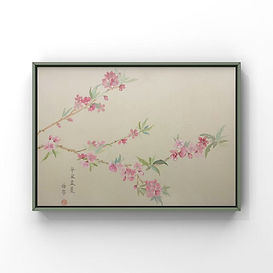
Branch Peach Blossom
Cathy Shen, 2020
Chinese Traditional Painting
Theme: Branch Flower-and-Bird Painting
Technique: Boneless (Mogu)
Material: 90% Matured Xuan Paper

Branch Wisteria
Cathy Shen, 2021
Chinese Traditional Painting
Theme: Branch Flower-and-Bird Painting
Technique: Boneless (Mogu)
Material: 90% Matured Xuan Paper

Branch Morning Glory
Cathy Shen, 2020
Chinese Traditional Painting
Theme: Branch Flower-and-Bird Painting
Technique: Boneless (Mogu)
Material: 90% Matured Xuan Paper

Desktop Screen with Pruned Flowering Branch Design
Cathy Shen, 2020
Chinese Traditional Painting
Theme: Branch Flower-and-Bird Painting
Technique: Boneless (Mogu)
Material: Matured Xuan Paper

Paeonia
Cathy Shen, 2022
Chinese Traditional Painting
Theme: Branch Flower-and-Bird Painting
Technique: Fine Brushwork (Gongbi)
Material: Processed Silk

Hollyhocks and Pomegranate Flowers
Cathy Shen, 2025
Chinese Traditional Painting
Theme: Branch Flower-and-Bird Painting
Technique: Boneless (Mogu)
Material: Processed Silk
The Art of Composition in Song Dynasty Branch Flower-and-Bird Paintings
The Song Dynasty (960-1279) represents a pinnacle in Chinese artistic achievement, particularly in the refined genre of flower and bird painting. Among the various approaches developed during this period, branch flower-and-bird painting (折枝花鸟画) emerged as a distinctive form that captured the essence of nature through selective representation rather than comprehensive depiction. This artistic approach, which focuses on isolated branches rather than entire plants, developed six principal composition methods that would profoundly influence East Asian art for centuries. Each technique demonstrates the Song masters' sophisticated understanding of balance, movement, and spatial relationships, transforming simple natural subjects into profound aesthetic statements.
The Six Classical Compositions
One-Wave Three-Fold Composition
The most emblematic of Song Dynasty techniques, the one-wave three-fold composition exemplifies the art of suggesting the whole through a carefully chosen part. Artists select the most captivating branch from a tree or flowering plant, allowing this single element to evoke the entire organism's vitality. The branch curves elegantly across the painting surface in three distinct undulations, creating a rhythmic flow that guides the viewer's eye through the composition. Lin Chun's masterpiece "Plum and Bamboo with Cold Birds" perfectly demonstrates this principle, with a plum branch entering from the upper left, bending gracefully through three sections before fanning outward. Birds and blossoms are strategically positioned along these curves to maintain visual equilibrium while enhancing the sense of natural movement. This composition conveys nobility and refinement, establishing itself as the gold standard among Song Dynasty artistic arrangements.
Three-Line Complementary Composition
Building upon principles of harmony and order, the three-line complementary composition introduces a more structured approach to spatial division. The primary branch extends horizontally across the picture plane, effectively bisecting the composition, while two supporting branches—one above and one below—create a tripartite arrangement. This technique transforms what could be monotonous linearity into a dynamic interplay of parallel and intersecting forms. The anonymous work "Litchi and Yellow Birds" exemplifies this method, where three branches of varying lengths create a hierarchy of visual importance. The resulting composition achieves a sense of calm stability without sacrificing vitality, as birds and insects animate the spaces between branches, contributing melodious notes to the visual symphony.
"V"-Shaped Composition
The "V"-shaped composition introduces angular dynamism through the strategic arrangement of contrasting elements. Two clusters of branches—deliberately varied in size and density—form a distinctive "V" pattern typically originating from the painting's lower edge. This technique masterfully employs contrast: significant against small, high against low, sparse against dense, creating visual tension that energizes the composition. The upper portion of the painting often remains deliberately empty, a void that paradoxically focuses attention on the primary subjects below while inviting contemplation of the unseen. This acute angular arrangement generates a sense of liveliness and movement, encouraging viewers to imagine the natural world extending beyond the picture's boundaries.
Corner Composition
The corner composition represents a revolutionary approach to pictorial space, inspired by the painter Shi Tao's principle of "clipping the head and tail." Rather than depicting complete forms, artists focus on revealing essential details, positioning the scene in one corner of the painting with branches extending from the edge and fruits or leaves only partially visible. This cropping technique creates an impression of accidental glimpse, as if the viewer has happened upon a perfect moment in nature. The deliberate use of space suggests a vast world beyond the frame's boundaries, embodying the aesthetic principle of "seeing the grand through the small." This composition achieves both intimacy and expansiveness, transforming limitation into artistic strength.
Surrounded and Suspended Composition
The final compositional type, the surrounded and suspended arrangement, presents perhaps the most abstract interpretation of natural forms. Branches appear completely detached from their source, floating in undefined space or arranged in vessels, creating a sense of ethereal suspension.Multiple flowers and leaves are elaborately arranged to achieve richness without clutter, each element carefully positioned to maintain visual harmony. Despite the apparent disconnection from natural context, these compositions retain a vital sense of life force, suggesting rather than depicting the connections to the natural world. The result is simultaneously decorative and profound, simple in appearance yet complex in its evocation of nature's essential energy.
Diagonal Composition
Among the six traditional forms, the diagonal composition stands as the most dramatically dynamic. A single, elegantly slender branch or towering stem cuts diagonally across the painting surface, creating an immediate sense of movement and direction. This bold compositional choice is tempered through careful orchestration of accompanying elements—flowers and leaves of varying shapes and sizes are distributed along the diagonal to achieve visual balance despite the inherent instability of the slanted line. The diagonal thrust generates tension and drama, while the artist's skillful manipulation of color temperature—balancing cool and warm tones—prevents the composition from becoming visually overwhelming. This technique transforms static botanical subjects into scenes charged with potential energy.






Thus, through careful manipulation of line, space, and balance, Song Dynasty artists transformed simple botanical subjects into profound meditations on life, growth, and natural harmony.


